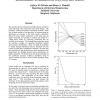Free Online Productivity Tools
i2Speak
i2Symbol
i2OCR
iTex2Img
iWeb2Print
iWeb2Shot
i2Type
iPdf2Split
iPdf2Merge
i2Bopomofo
i2Arabic
i2Style
i2Image
i2PDF
iLatex2Rtf
Sci2ools
IMAGING
2000
2000
Illuminant Estimation: Beyond the Bases
We describe spectral estimation principles that are useful for color balancing, color conversion, and sensor design. The principles extend conventional estimation methods, which rely on linear models of the input data, by characterizing the distribution or structure of the linear model coefficients. When the linear model coefficients of the input data are highly structured, it is possible to improve the quality of a simple linear model by estimating coefficients that are invisible to the sensors. We illustrate these principles using the synthetic example of estimating blackbody radiator spectral power distributions. Then, we apply the principles to typical daylight illuminants that we measured over the course of twenty days in Stanford, California. We show that the distribution of the daylight linear model coefficients that approximate the daylight spectral power distributions are highly structured. We further show that from knowledge of the coefficient structure, nonlinear algorithms...
IMAGING 2000 | IMAGING 2001 | Linear Model | Linear Model Coefficients | Spectral Power Distributions |
| Added | 01 Nov 2010 |
| Updated | 01 Nov 2010 |
| Type | Conference |
| Year | 2000 |
| Where | IMAGING |
| Authors | Jeffrey M. DiCarlo, Brian A. Wandell |
Comments (0)

